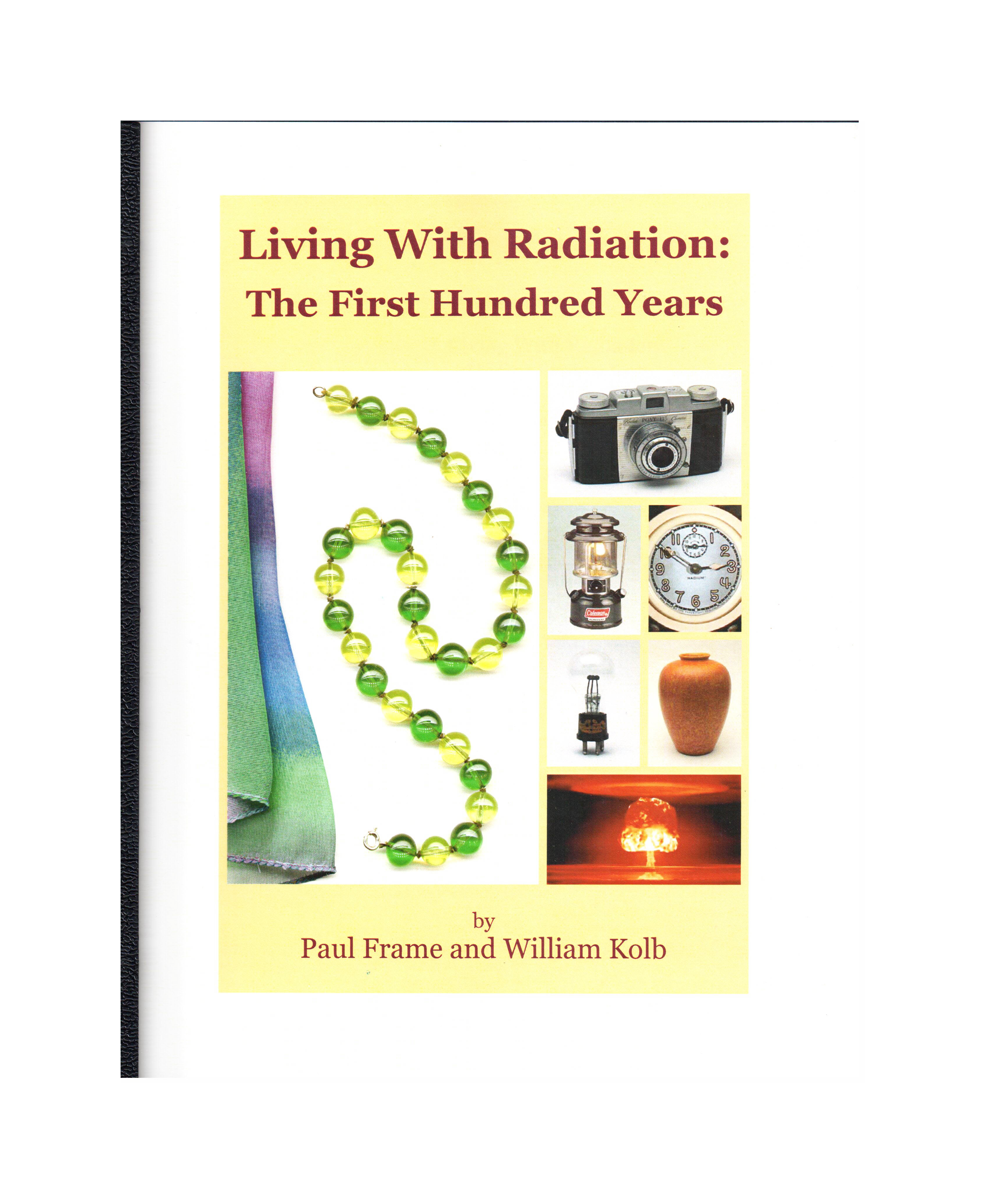Living With Radiation
Product successfully added to the Quote List
Description
Living With Radiation: The First Hundred Years
By Paul Frame & William Kolb
In the century since radioactivity was discovered, radioactive substances have been used extensively for a number of applications. Especially in the early part of the 20th century, and to a lesser extent today, a number of commonly available products have been radioactive. These include:
- luminous watch dials (radium and tritium)
- orange ceramicware (notably Fiestaware from the 40s and 50s; uranium oxide)
- smoke detectors (americium 241; in current use)
- gas camping lantern mantles (thorium; some manufacturers no longer use this)
- camera lenses (thorium)
- static eliminators for film and records (polonium 210)
- welding rods and arc lamps (thorium)
- vacuum tubes (thorium was used to increase electron emission)
A fascinating look at the proliferation of uses of radioactive materials in the last century can be found in the book “Living with Radiation: The First Hundred Years” by Paul Frame and William Kolb. It tells the story of the use of radioactive materials in consumer and commercial products in the century since radioactivity was discovered.
Fifth edition; copyright William M. Kolb and Paul Frame, 2012; 317 pages, numerous photographs.
Table Of Contents
Preface
The Early Years
Military, Commercial and Consumer Products
1. Naturally Occurring Radioactivity
1.1 Radiation in the Natural Environment
1.1.1 Rocks and Minerals
1.1.1.1 Mineral Collections and Commemorative Items
1.1.1.2 Gemstones and Costume Jewelry
1.1.1.3 Fossil Fuels
1.1.1.4 Construction Materials
1.1.1.5 Kaolin
1.1.1.6 Cat Litter
1.1.2 Water
1.1.2.1 Mineral Springs and Health Spas
1.1.2.2 Wells
1.1.2.3 Radon Removal Systems
1.1.3 Air
1.1.3.1 Health Mines
1.1.3.2 Natural Gas
1.1.3.3 Radon Detectors
1.1.3.4 Air Filters, Ionizers, and Electrostatic Precipitators
1.1.4 Cosmic Radiation
1.1.4.1 Air Travel
1.1.4.2 Space Travel
1.1.4.3 Thunderstorms
1.2 Radiation in Food, Tobacco, and Health Care Products
1.2.1 Food and Food Additives
1.2.1.1 Brazil Nuts
1.2.1.2 Low Sodium Salt and Potassium Compounds
1.2.2 Phosphates and Fertilizers
1.2.3 Tobacco
1.2.4 Health Care Products
2. Radioactivity Essential to Product Function
2.1 Quackery and Questionable Medical Products
2.1.1 Mild Radium Therapy
2.1.2 Non-Radioactive Health Products
2.2 Radioluminescent Products
2.2.1 Instruments, Gauges, Markers, etc.
2.2.2 Radioluminescent Watches and Clocks
2.2.3 Spinthariscopes
2.2.4 Glow-in-the-Dark Toys
2.3 Ion Producing Devices
2.3.1 Lightning Rods
2.3.2 Electron Tubes
2.3.3 Irradiated Spark Gaps
2.3.4 Density, Moisture and Thickness Gauges
2.3.5 Gas Chromatographs
2.3.6 Smoke and Aerosol Detectors
2.3.7 Tobacco Denaturizers
2.3.8 Air Deodorizers
2.3.9 Chemical Detectors
2.3.10 Static Eliminators
2.4 Nuclear Powered Devices
2.4.1 Nuclear Batteries
2.4.2 Pacemakers
2.5 X-ray Fluorescence Analyzers
2.6 Radioactivity from Other Sources
2.6.1 Check Sources
2.6.2 Sand Consolidation
2.6.3 Safety Controls
2.6.4 Science, Chemistry, and Mineral Sets
2.6.5 Advertisements, Souvenirs and Mementos
2.6.6 Nuclear Medicine
3. Radiation Electronically Generated by Product
3.1 X-rays from Vacuum Tubes and Spark Coils
3.2 Medical X-rays
3.3 Hair Removal
3.4 Shoe-Fitting Fluoroscopes
3.5 Personnel Scanning Systems
3.6 Airport Inspection Systems
3.7 Television Receivers
3.8 Monitors and Video Display Terminals
3.9 Night-Vision Equipment
4. Radioactivity Incidental to Product Function
4.1 Uranium
4.1.1 Uranium Metal
4.1.1.1 Containers and Shielding
4.1.1.1 Weights and Counterweights
4.1.1.3 Frizzens and Flints
4.1.1.4 Depleted Uranium Munitions
4.1.1.5 Public Relations
4.1.2 Uranium Compounds
4.1.2.1 Photographic Prints, Slides and Negatives
4.1.2.2 Advertisements
4.1.3 Uranium in Glass
4.1.3.1 Glassware
4.1.3.2 Neon Signs and Geissler Tubes
4.1.3.3 Uranium Glass Filters
4.2 Thorium
4.2.1 Thorium Metal
4.2.1.1 Thorium Alloys
4.2.1.2 Welding Rods
4.2.1.3 Arc Lamps and Electric Lights
4.2.2 Thorium Compounds
4.2.2.1 Gas Lantern Mantles
4.2.2.2 Thorotrast
4.2.2.3 Neutron Dosimeters
4.2.2.4 Optical Coatings
4.2.3 Thorium in Optical Glass
4.3 Uranium and Thorium in Ceramics
4.3.1 Glazes
4.3.2 Glass Enamel
4.3.3 Porcelain Dentures
4.3.4 Ceramics
4.3.5 Crucibles
4.3.6 Insulation
4.3.7 Abrasives
4.3.8 Piezoelectric Ceramics
4.4 Rare Earths
4.4.1 Rare Earth Glass
4.4.1.1 Optical Glass
4.4.1.2 Eyeglasses
4.4.1.3 Television Faceplates
4.4.1.4 Automotive Window Glass
4.4.2 Rare Earth Magnets
4.4.3 Other Rare Earth Products
5. Radioactive Contamination in Product
5.1 Gems
5.2 Jewelry
5.3 Steel
5.4 Static Eliminators
6. Radiation Used to Manufacture Product
6.1 Food, Cosmetics and Medical Supplies
6.2 Precious and Semi-Precious Gemstones
6.3 Atomic Marbles
6.4 Golf Balls
6.5 Lichtenberg Figures
The Next 100 Years
End Notes
Photo Credits and Details
Appendix A: Radioactive Electron Tubes
Appendix B: Radioactive Military Items
Appendix C: Uranium Glazes
Appendix D: Potteries
Appendix E: Science Sets
Appendix F: Photographic Processes
Appendix G: Radioactive Minerals
Appendix H: Glands and Radium
Appendix I: Radiation Detection and Measurement
Appendix J: Activity of Radioactive Elements
Appendix K: Biological Effects of Radiation
Appendix L: State Radiation Control Program Directors
Appendix M: Regulations on Owning and Shipping Radioactive Materials
Appendix N: Online Resources
Appendix O: Radiation Units and Conversions
Appendix P: Radioactive Antique Price Guide
Preface
Ionizing radiation is everywhere in the natural environment but it wasn’t until the closing years of the 19th Century that its existence was discovered by Becquerel. Uses for this new phenomenon grew rapidly after Roentgen produced the first x-rays and the Curies isolated the intensely radioactive element radium and established its unusual properties. By the middle of the 20th Century, man-made radioactive elements and radioactive isotopes not found in nature had been synthesized and incorporated in numerous commercial products. Electronic devices that could produce penetrating rays just like those from radioactive substances were also increasing in number and availability.
The many ordinary and remarkable uses of radiation in military, commercial, and consumer products over the past century are chronicled here in an effort to preserve this vanishing history. While many of these items are no longer made, they occasionally turn up in attics, yard sales, war surplus bins, antique shows, estate sales, electronic flea markets, and on the Internet. Other items are as near as a grocery shelf or garden store. Some of these products still contain substantial quantities of radium or other radioactive nuclides. Such sources have caused injuries and death, and must be treated with extreme care. If a radioactive source breaks, leaks or is opened, it can spread contamination that is invisible to the eye and that can go unnoticed. In such an event, state authorities should be contacted immediately. Owning radioactive materials presents other problems as well. In some states devices such as the Revigator must be registered (e.g., Michigan) or licensed (e.g., Illinois), and this may require an annual fee. Various rules and regulations governing radioactive materials and a list of state radiation control program directors has been provided for quick reference.
A number of different units for measuring radiation are in current use and found throughout this text. Best known is the Roentgen, a measure of gamma ray (x-ray) energy. Gamma-ray and x-ray exposures are often expressed in terms of milliRoentgens per hour (mR/hr). The dose or amount of radiation actually absorbed in a gram of tissue, however, is expressed in units of radiation absorbed dose (rads). A Roentgen equivalent man (rem) is the amount of absorbed radiation when adjusted for relative harmfulness compared to ordinary x-rays. Radiation workers including miners, nuclear power plant personnel, and nuclear medicine technicians, are permitted whole-body doses up to 5000 millirem per year (mrem/year). The recommended whole-body limit for non-radiation workers is a tenth of this, or 500 mrem per year. For the types of devices described here, it can be assumed that a one hour exposure at 1 milliRoentgen per hour produces a dose no greater than 1 millirad (mrad) or 1 millirem (mrem). The actual dose is likely to be much less because most of the items are small and radiation intensity falls off rapidly with distance. A small source producing 100 mR/hr at one inch, for example, produces less than 1 mR/hr at one foot. Nevertheless, radiation risk is cumulative and efforts should be made to minimize exposure from all sources by distance, shielding, and duration of exposure.

